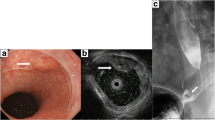Abstract
Gastric endocrine cell carcinoma is a relatively rare tumor. We experienced a case of early gastric cancer in which an endocrine cell carcinoma was identified within a differentiated adenocarcinoma, and a component of this endocrine cell carcinoma had metastasized to lymph nodes of the stomach. In its 2010 revision regarding digestive system tumors, WHO classified cancer cells with characteristics of both glandular system cells and neuroendocrine cells as mixed adeno neuroendocrine carcinoma (MANEC) under the neuroendocrine carcinoma (NEC) category. In this case, we observed an endocrine cell carcinoma continuous with an intramucosal differentiated adenocarcinoma, and cancer cells with an irregular gland duct structure were observed in the proliferative portion of the submucosal tissue. In addition, there was a 35 mm size lymph node metastasis in the lesser curvature of the stomach consisting entirely of poorly differentiated cancer cells with polymorphic, highly atypical nuclei and scant cytoplasm. Immunohistological analysis showed that the endocrine carcinoma in the gastric mucosa was chromogranin A positive and the infiltrated area of the submucosal tissue was also chromogranin A positive. The lymph node metastasis was positive not only for chromogranin A, but also for Synaptophysin and CD56. Furthermore, the Ki67 labeling index was high at approximately 80 % for the gastric endocrine cell carcinoma and approximately 90 % for the lymph node metastases. Until now, there are no reports related to the patients with early gastric cancer accompanied with lymph node metastasis of MANEC. This case is very interested in considering the mechanism of lymph node metastasis of MANEC. The patient has shown no sign of recurrence for 1 year and 4 months after postoperative chemotherapy.







Similar content being viewed by others
References
Kubota T, Ohyama S, Hiki N, Nunobe S, Yamamoto N, Yamaguchi T (2012) Endocrine carcinoma of the stomach: clinicopathological analysis of 27 surgically treated cases in a single institute. Gastric Cancer 15:323–330
Rindi G, Bordi C, Rappel S, Rosa SL, Stolte M, Solcia E (1996) Gastric carcinoids and neuroendocrine carcinomas: pathogenesis, pathology, and behavior. World J Surg 20:168–172
Caruso RA, Heyman MF, Rigoli L, Inferrera C (1998) Composite early carcinoma (ordinary adenocarcinoma, carcinoid, microglandular-goblet cell carcinoid, neuroendocrine mucinous carcinoma) of the stomach. Histopathology 32:569–571
Jang KY, Moon WS, Lee H, Kim CY, Park HS (2009) Gastric collision tumor of large cell neuroendocrine carcinoma and adenocarcinoma: a case report. Pathol Res Pract 206:387–390
Bensch KG (1983) The problem of classifying peripheral endocrine tumors. Hum Pathol 14:383–385
DeLiis RA, Dayal Y, Wolfe HJ (1984) Carcinoid tumors. Changing concepts and new perspectives. Am J Surg Pathol 8:295–300
Rindi G, Arnold R, Bosman FT, Bosman FT (2010) Nomenclature and classification of neuroendocrine neoplasms of the digestive system. In: Bosman FT, Carneiro F, Hruban RH, Thise ND (eds) WHO Classification of tumours of the Digestive System. IARC Press, Lyon, pp 13–14
Nishikura K, Watanabe H, Iwafuchi M, Fujiwara T, Kojima K, Ajioka Y (2003) Carcinogenesis of gastric endocrine cell carcinoma: analysis of histopathology and p53 gene alteration. Gastric Cancer 6:203–209
Blumenfeld W, Chandhoke DK, Sagerman P, Turi GK (1996) Neuroendocrine differentiation in gastric adenocarcinomas. An immunohistochemical study. Arch Pathol Lab Med 5:478–481
Jin EH, Lee DH, Jung SA, Shim KN, Seo JY, Kim N, Shin CM, Yoon H, Jung HC (2015) Clinicopathologic factors and molecular markers related to lymph node metastasis in early gastric cancer. World J Gastroenterol 2:571–577
Kim JJ, Kim JY, Hur H, Cho YK, Han SU (2011) Clinicopathologic significance of gastric adenocarcinoma with neuroendocrine features. J Gastric Cancer 4:195–199
Namikawa T, Oki T, Kitagawa H, Okabayashi T, Kobayashi M, Hanazaki K (2013) Neuroendocrine carcinoma of the stomach: clinicopathological and immunohistochemical evaluation. Med Mol Morphol 46:34–40
Volante M, Brizzi MP, Faggiano A, La Rosa S, Rapa I, Ferrero A, Mansueto G, Righi L, Garancini S, Capella C, De Rosa G, Dogliotti L, Colao A, Papotti M (2007) Somatostatin receptor type 2A immunohistochemistry in neuroendocrine tumors: a proposal of scoring system correlated with somatostatin receptor scintigraphy. Mod Pathol 11:1172–1182
Author information
Authors and Affiliations
Corresponding author
Rights and permissions
About this article
Cite this article
Taguchi, J., Shinozaki, K., Baba, S. et al. A resected case of neuroendocrine carcinoma of the stomach with unusual lymph node metastasis. Med Mol Morphol 49, 34–41 (2016). https://doi.org/10.1007/s00795-015-0100-9
Received:
Accepted:
Published:
Issue Date:
DOI: https://doi.org/10.1007/s00795-015-0100-9




